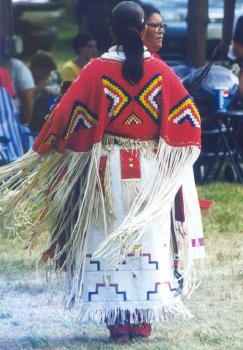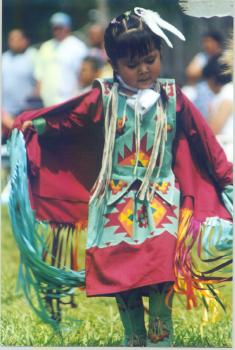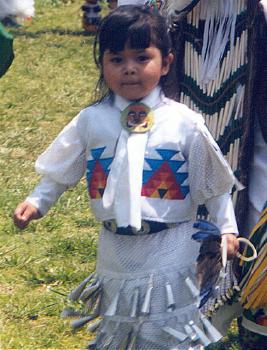|
|
Pow Wow Dance Styles
by Vicki Lockard last in a series
Photos by Paul Barry and Jamie Lockard
| Dancing creates excitement at powwows! This is the last of the articles about powwows Dance styles may vary from area to area. Women's Traditional  Women's Traditional is the oldest type of women's dance. It is sometimes referred to as Straight or
Buckskin Dancing, and like Men's Traditional there are many variations in the regalia. Women's Traditional is the oldest type of women's dance. It is sometimes referred to as Straight or
Buckskin Dancing, and like Men's Traditional there are many variations in the regalia.There are two important items used by Traditional Dancers. One, is the fan. This fan is usually beaded and is raised to the drum, in honor, during the "honor" beats of the songs. The second item, is the shawl. This colorful, fringed shawl is carried over one arm. The fringe of the shawl sways with the movement of the dancer. Traditional Dancers wear beautiful jewelry. Many wear breastplates that hang to their knees. The hair barrettes are hand beaded and the women often have beaded pieces for the fur pieces that hang from their hair. The moccasins are either fully beaded (Northern style) or accent beaded (Southern style). Traditional dancers move with grace and elegance. They sway to the beat of the drum and slightly bend their knees. Although the movement is slight, the effect created by the movement of their fringe is breathtaking. Women's Fancy Shawl  Ladies Fancy Shawl Dancing is similar in style and brightness to Men's Fancy Dancing. The Ladies Fancy
Dance is the newest form of dancing and has come from the Northern Tribes along the U.S.-Canadian border. Ladies Fancy Shawl Dancing is similar in style and brightness to Men's Fancy Dancing. The Ladies Fancy
Dance is the newest form of dancing and has come from the Northern Tribes along the U.S.-Canadian border.The major feature of this regalia is the brightly colored shawl, worn over the shoulders. These are elaborately designed with appliqué, ribbon work, and painting. The long fringe that hangs from the edges flies around the dancer as she jumps and spins to the music. Legend says, "the young ladies and their shawls represent the transition from a cocoon to a beautiful butterfly in flight." A famous Pow Wow MC once said of these dancers, "they're so light on their feet that the grass doesn't even bend under their moccasins where they dance." Women's Jingle Dance  Based upon a young Ojibwe woman's dream, the Jingle Dress dance is revered as a healing dance. Legend
says, "the Jingle Dress was given to Indian people in a vision." The Jingle Dress is often referred to
as a "healing dress" and Jingle Dress Based upon a young Ojibwe woman's dream, the Jingle Dress dance is revered as a healing dance. Legend
says, "the Jingle Dress was given to Indian people in a vision." The Jingle Dress is often referred to
as a "healing dress" and Jingle Dressdancers are sometimes called upon to dance for a sick or injured community member. Cones shaped from chewing tobacco lids are positioned upon masterfully designed cut dresses. Traditionally, a cone is secured on the dress for each day of the year (365 cones). The Jingle Dance has been termed "jingle" for the "shuck-shuck" noise they make. |
|
|
| Canku Ota is a free Newsletter celebrating Native America, its traditions and accomplishments . We do not provide subscriber or visitor names to anyone. Some articles presented in Canku Ota may contain copyright material. We have received appropriate permissions for republishing any articles. Material appearing here is distributed without profit or monetary gain to those who have expressed an interest. This is in accordance with Title 17 U.S.C. section 107. |
|
Canku Ota is a copyright of Vicki Lockard and Paul Barry. |
|